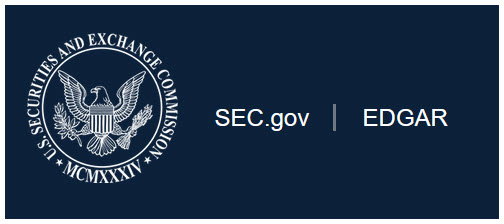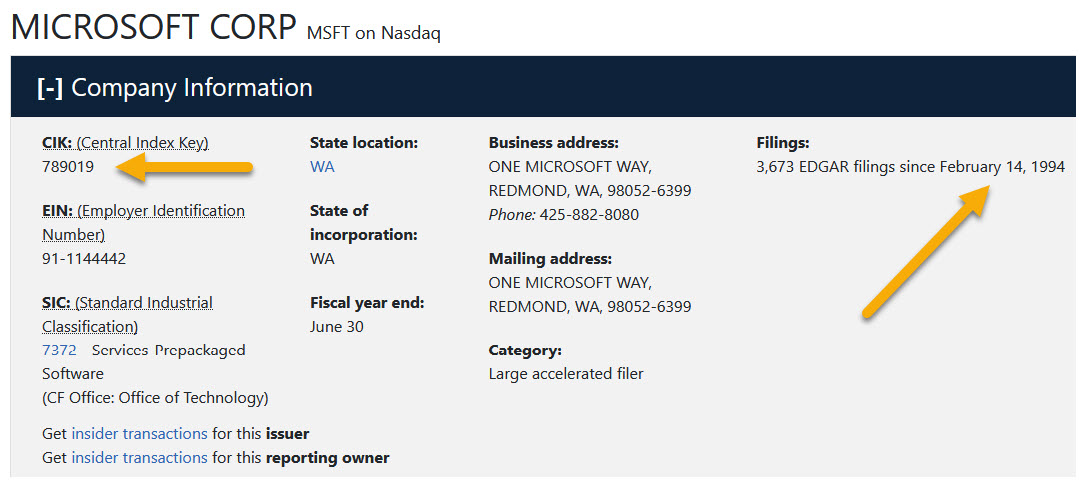
Resource of the Month: EDGAR
August 14, 2021

The EDGAR (Electronic Data Gathering, Analysis and Retrieval) database is an electronic filing system created by the U.S. Securities and Exchange Commission (SEC) to increase the efficiency and accessibility of corporate filings. It enables researchers to search for public company financials and operations filings required by law.

Key points:
- Search by Company Name, Ticker or CIK (A Central Index Key is a unique number the SEC assigns to each EDGAR filer)
- Filings are searchable back to 2001 in EDGAR, but earlier filings are available back to 1994 using Historical EDGAR.

- By clicking on the + more search options, you can get to the filing category search that allows you to filter your search to a specific filing type. Clicking on Browse filing types gives you the complete listing of options.
6 Most Popular Filing Types:
- 10-K -- Annual Report -- Provides audited annual financial statements, a discussion of material risk factors for the company and its business, and a management’s discussion and analysis of the company’s results of operations for the prior fiscal year
- 10-Q -- Quarterly Report -- Provides unaudited quarterly financial statements, updates regarding material risks that the company faces, and management’s discussion and analysis of the company’s results of operations for the prior fiscal quarter.
- 8-K -- Current Report – Filed to report any current activity that requires public notice. Discloses material events or information that the company chooses or is required to make public prior to its next scheduled quarterly or annual report.
- PRE 14A & DEF 14A -- Proxy Statements -- Public companies, mutual funds, and ETFs that are subject to SEC proxy rules send proxy statements to their shareholders to solicit their votes at shareholder meetings. Proxy statements describe the matters to be voted on at the meeting and may include compensation and other information about the company’s or fund’s board and executive officers.
- S-1 -- Registration statement – Filed to register the offer and sale of securities to the public often in connection with an initial public offering.
- D -- Notice of sales of unregistered securities -- Companies may use an exemption under Regulation D to offer and sell securities without having to register the offering with the SEC. When relying on such an exemption, companies must file a "Form D" after they first sell their securities.
Don’t forget to click on the plus sign under the Company name to explore more information about the company.

Here are some examples of ways to use EDGAR that you can test out on your own:
- Explore a mature company’s progression over time by looking at the evolution of their 10-K’s. For example, take a look at Microsoft Corp | Ticker (MSFT) | CIK (789019) and compare the company’s 10-K from 1994 with the most recent 10-K from 2021. In addition to the information about Microsoft Corp’s development, you can also see that the form is now filed in a Structured Data format called Inline XBRL. More about Structured Data [Inline XBRL]. Companies are adopting this format to submit their filings. The idea is that data structured at a high level of granularity will be useful for text analytics.
- Use the full text search option to find all the 10-K’s in the last two years that mention the “American Rescue Plan” or the “Cares Act” and look through the results to get an indication of the impact on U. S. Public Companies.
- Search Form S-1’s filed in the last month to view names of companies and get an idea of the number of companies going public in the last month.
- Search the exhibits of 10-Ks for U. S. Public Companies in a specific industry of interest to see what types of legal forms that industry files and examples of what those legal filings look like.
What information do you want to find/discover? What EDGAR search did you use to discover your answer? We would love to hear from you about your experiences using this resource! Just reach out to us through the Reference Desk, we are only a click or two away.
Resources consulted:
Harvard Law School Library. (2014, March 5). Finding and Understanding SEC Documents [Video]. YouTube. https://youtu.be/TQ1GzeWdCps
U.S. Securities and Exchange Commission. (2007, July 19). How Do I Use EDGAR? https://www.sec.gov/edgar/quickedgar.htm
U.S. Securities and Exchange Commission. (2018, September 15). Using EDGAR to Research Investments
https://www.sec.gov/oiea/Article/edgarguide.html
Resource of the Month provides a very brief introduction to useful library databases, highlighting key features you should know about. If you would like more information about this resource (or any of the library’s databases), please contact us for research assistance. If you would like a demonstration of these resources for a class, please schedule a research instruction class using the instruction request form.
